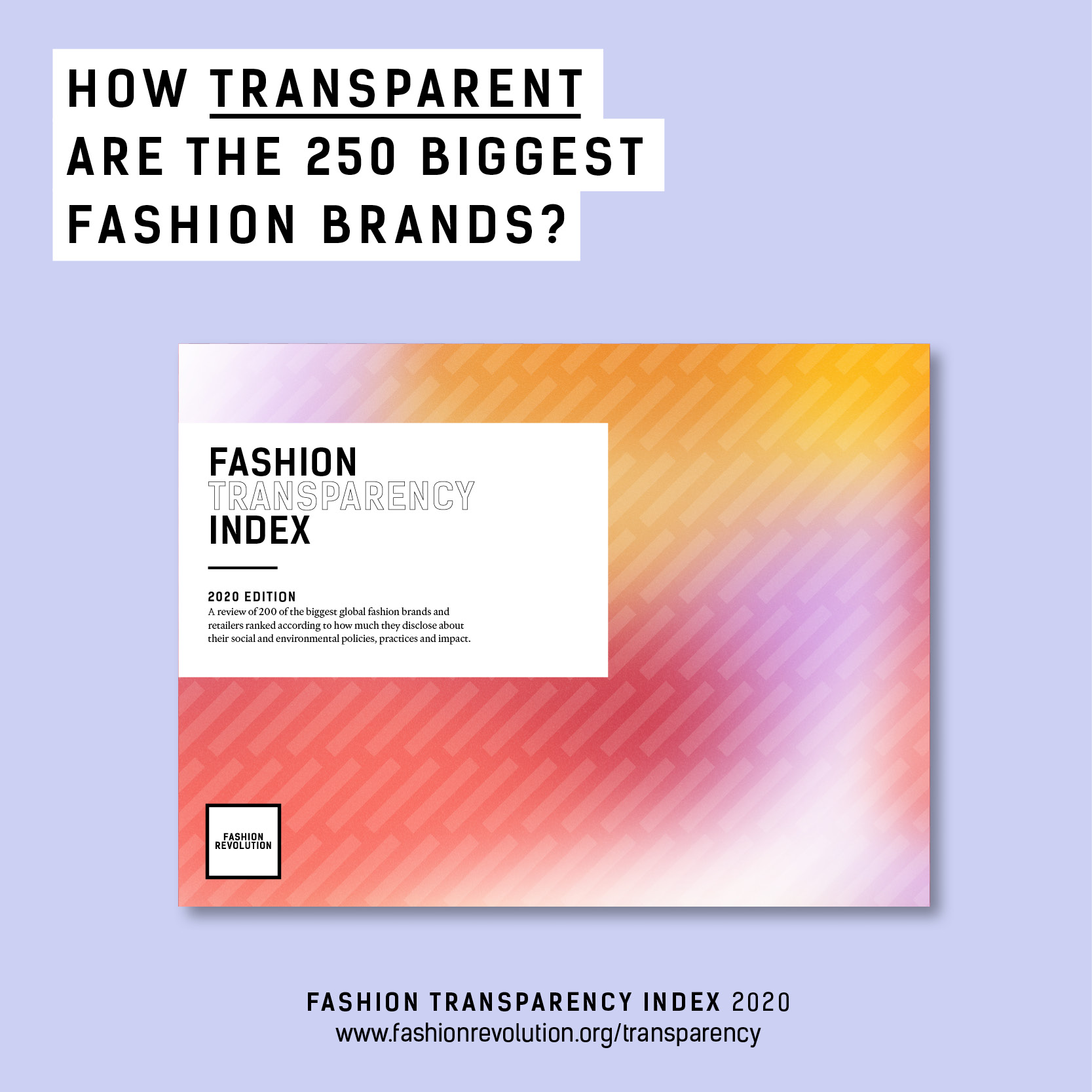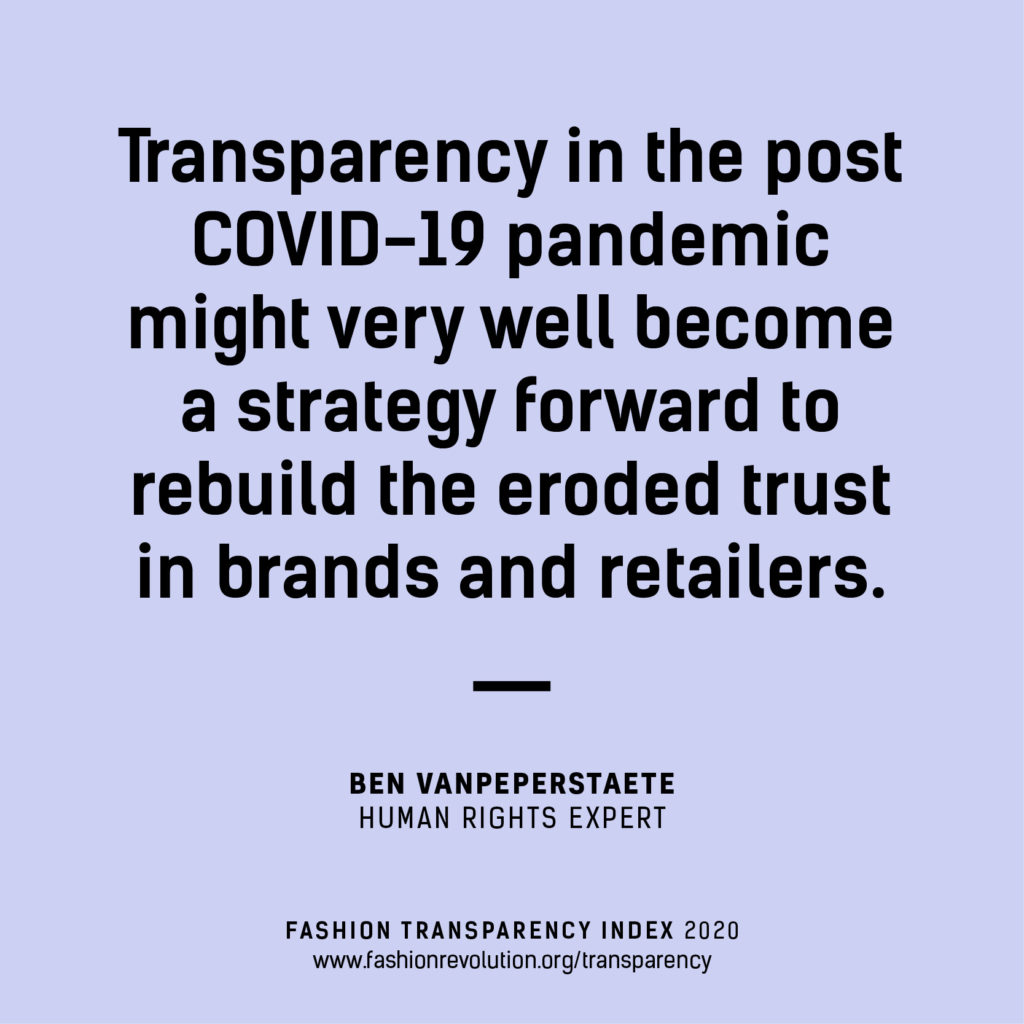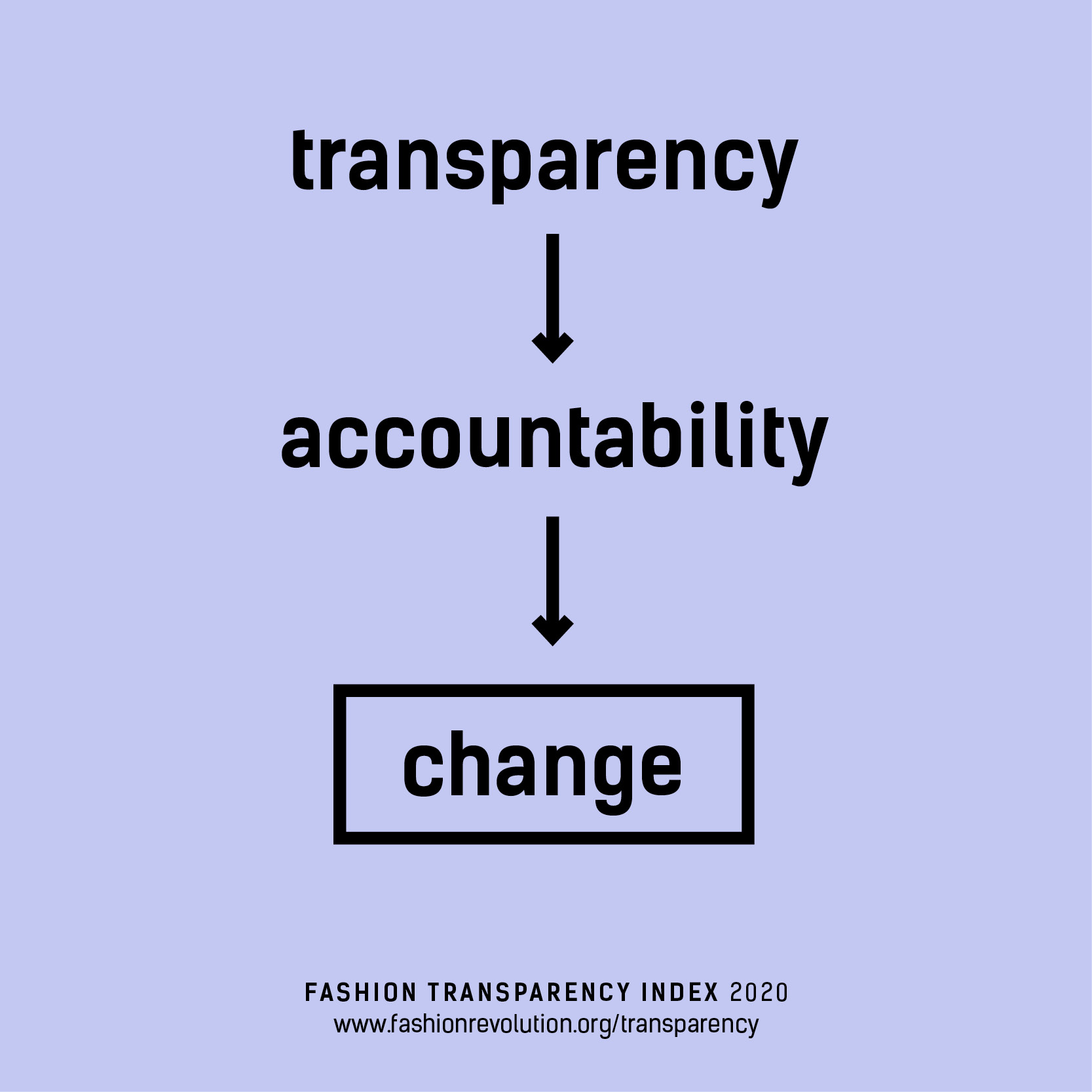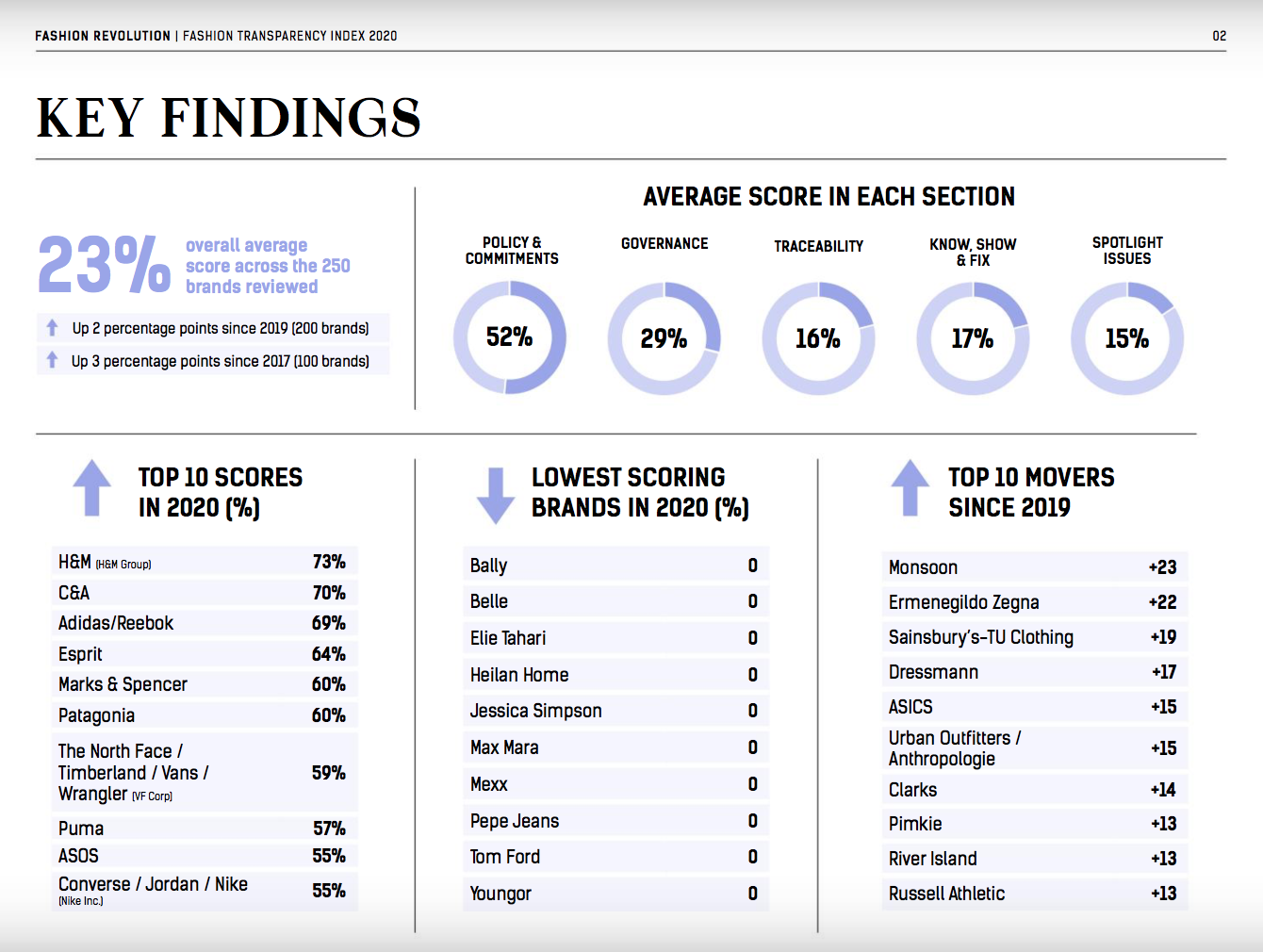
The 5th edition of Fashion Revolution’s Fashion Transparency Index was introduced by founder and Global Operations Manager Carry Somers at a virtual press conference held during Fashion Revolution Week 2020. Addressing the current pandemic, Somers highlighted the ever more pressing significance of the findings of the FTI in relation to the fight for the rights of garment workers during this time of crisis:
“At a time when the fashion industry is clearly in turmoil, millions of workers from most profitable companies have been laid off, and are not receiving their pay. The vast majority of workers in supply chains have no savings and no insurance or rights.”
Many global brands making billions in profits year on year have cancelled orders through freedom of responsibility clauses in their contracts, leaving their factories and supply chain workers in dire financial situations. All the while shareholders continue to take a profit, and having named their manufacturers as ‘partners’ within their CSR (Corporate and Social Responsibility) reports, they abandon responsibilities to these ‘partners’ now. Only 5% of the brands in the FTI disclose supplier feedback about their behaviour, leaving their ‘partners’ without a platform to communicate this treatment.

The pandemic has caused consumers to reassess and reprioritise their spending resulting in a surge of garment waste from retailers unable to sell their stock. Very few brands currently publish data about their annual production volume, so the quantity of waste is impossible to track. Only 9% of the brands in this FTI published the number of products manufactured in one period. Brands publishing steps to reduce pre consumer waste amounted to 27% and only 30% have take-back schemes. Without traceability, brands are able to navigate this waste problem without being held accountable for their methods.
RANKING TRACEABILITY – NOT SUSTAINABILTY:
Fashion Revolution believes that transparency across supply chains within the fashion industry is the key to facilitating brand accountability and in doing so bringing about fundamental change.

The FTI benchmarks the public disclosure from 250 brands (+50 brands from 2019) across 5 key areas: Policy and Commitments, Governance, Traceability, Know, show & fix, and Spotlight issues. Their ranking system does not rate brands on how ethical or sustainable their practices are- it only investigates how readily available brands make information about these areas to consumers and stake holders. It is important therefore to remember that the brands most highly ranked here are not necessarily the most sustainable or ethical.
HOW IS THE DATA GATHERED?
220 indicators from 55000 individual data points are researched across brands with a methodology focussed on public disclosure. The research team fills out questionnaires for each brand, gathering as much publically available information as they can, and this is forwarded to brands to fill in the blanks. This year 53% of brands participated- the highest participation rate to date. Participating brands averaged 35%, whilst those not contributing averaged 11%. Data suggests that participation from brands does influence their ranking because they are able to highlight published information that could have been missed. It is important to note that brands are included in the FTI whether they actively participate or not.
POSITIVE CHANGE IDENTIFIED SINCE 2019:

No brands this year scored above 80%, +10% since 2019 where no brands scored above 70%. The average score in 2020 is 23%, +2% from 2019.
The top 5 ranked brands within the FTI remain the same as 2019, but in a different order. H&M were highest this year, achieving 73%, followed by C&A at 70%, Addidas/Reebok with 69% and Espirit with 64%. Last year Adidas scored the highest ranking, and although they are down this year, they have done well to be in the top 5 brands each year since 2016.
Of some of the luxury brands included, Balenciaga and St Laurent scored 47%, with Burberry at the lower end scoring 36%. Gucci was the highest scoring luxury brand, and the only brand to score 100% within ‘Policy and Commitments’.
Some of the most improved brands this year were Monsoon +23%, River Island +13% and Sainsbury’s-TU Clothing +19% (a continued improvement as TU were also on this list in 2019).
Whilst acknowledging that drastic improvement is still required, FTI report author and global policy director Sarah Ditty noted the significant progress from 2019-2020 in the increase of brands publishing their supplier lists:
- 48% are publishing their first tier manufacturers (+5% since 2019)
- 24% are publishing their processing facilities (+5% since 2019)
- 7% are publishing their raw materials suppliers (+2% since 2019)
AREAS OF PARTICULAR CONCERN:
Scores remained the same for 30 brands 2019-2020, and 10 brands scored 0%. These include Max Mara, Tom Ford, Jessica Simpson and Pepe Jeans. This is a disappointing insight into the industry wide lack of engagement with transparency.
An important intention of the FTI is to initiate the implementation of fair, clean and safe working environments across fashion’s vast supply chain. Unions for workers are an essential part of this revolution. Just 4% of brands revealed whether the factories they work with have trade unions for their workers- only +2% since 2019. This increase is nowhere near significant enough.
The FTI research team found that the websites of many brands contained repetitive, jargon filled ‘information’ and ‘fluffy story telling’- counter productive to transparency. Sarah Ditty outlined this problem of ‘information dumping’, suggesting it seemed like a deliberate strategy to greenwash and bury information away from consumers and stakeholders.

Considering the increased global attention on ocean plastic pollution and micro-fibre shedding from textiles, it was surprising that only 20% of brands published information regarding their policies to tackle micro-fibre pollution. To bring attention to this problem, Fashion Revolution have introduced the hashtag ‘What’s in my clothes?’ to encourage consumers to ask brands this important question throughout Fashion Revolution Week and beyond.
FTI’S GOALS FOR 2021:
Across the next 12 months, the FTI will continue to map and publically disclose supply chains, partnering with industry alliances to achieve this.
Driven by the ever-prevalent climate emergency, the FTI will continue to push brands to publish their supply chain information alongside the UN Fashion Industry Climate Charter. Whilst 78% of brands published carbon emissions of their own company (usually only including head offices, retail outlets and warehouses- their lowest emission ‘zones’) only 16% published the carbon emissions of their whole supply chain (where the majority of emissions occur). This information gap is one the FTI intends to fill.

Contained within the publication of 2020’s Fashion Transparency Index are detailed statistics communicated through easily accessible diagrams and illustrations. To access the official publication and learn more, visit the Fashion Revolution website.

Subscribe To Our Newsletter
Join our mailing list to receive the latest news and updates from our team.








